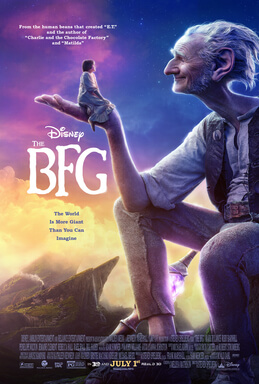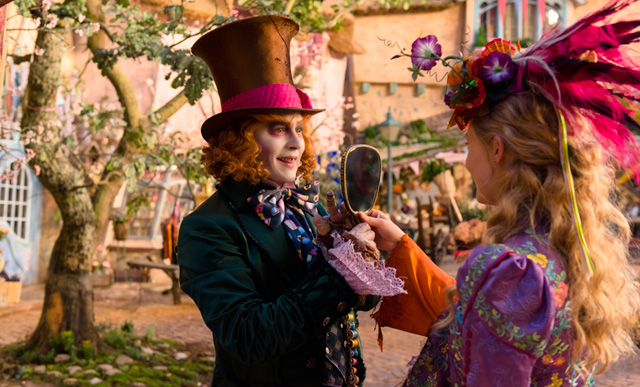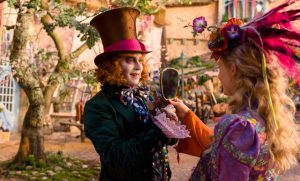The BFG
Posted on June 30, 2016 at 5:50 pm
B+| Lowest Recommended Age: | Kindergarten - 3rd Grade |
| MPAA Rating: | Rated PG for action/peril, some scary moments and brief rude humor |
| Profanity: | None |
| Alcohol/ Drugs: | Brief scene with drunken characters |
| Violence/ Scariness: | Extended fantasy-style violence, reference to off-screen violence, including death of children, but no characters injured |
| Diversity Issues: | None |
| Date Released to Theaters: | July 1, 2016 |
| Date Released to DVD: | November 28, 2016 |
| Amazon.com ASIN: | B01G4N5Q0A |

Steven Spielberg. the director who, with his partners, named their movie studio Dreamworks, understands that movies are like a guided dream. Roald Dahl’s story is about a Big Friendly Giant who collects, selects, edits, and delivers dreams to make people happy and conveys messages that are beyond the capacity of verbal human interaction. Clearly, this story connects with Spielberg profoundly, and it shows.
At 3 am one night in 1983, a girl named Sophie (Ruby Barnhill) is the only one awake in the horrible London orphanage where she lives. We can see right away that she is brave and smart, even fierce, as she threatens to call the cops on some drunken revelers making noise in the street. But then she witnesses a disturbance of another kind. Someone very, very large, as tall as her building, is walking quietly — no, stealthily — through the streets.
And then an enormous hand reaches silently and carefully into the window of the room filled with sleeping girls and the very awake Sophie, and grabs her, quilt and all. It is a giant.
He knows how to stay hidden. We see him employ some clever camouflage that keeps the Londoners from seeing him, and then takes off for Giant country, far, far away, but a matter of moments if you’ve got giant legs to leap with. Sophie is terrified. She is sure that the giant wants to eat her. But he does not eat children, he tells her, in his funny, corkscrew, word-twisting language. He has only taken her because she saw him, and he cannot risk her telling anyone about him. He has taken her to keep her from giving away his secret, which means she will have to stay with him forever.
Sophie is determined to run away. But that night, in the crow’s nest of a ship that is one of the many curios crowding his home, she dreams that she escapes, only to be captured and eaten by some even bigger giants. Through this dream, she begins to understand what her giant, soon to be known as the BFG, can’t explain any other way. She cannot be safe if she leaves his house. The other giants, who are as big to him as he is to Sophie, are uncivilized brutes and bullies. They eat “human beans,” including children (a bit less grisly than in the book, but still creepy).
The BFG, whose huge ears listen to everything, even the quietest whisperings of the heart, collects dreams. Sophie goes with him to the place where dreams grow, and she helps him deliver the happiest possible dreams to a young boy and his family. The lonely little girl and the lonely giant get to know one another, and become friends. But the other giants can smell her, and they won’t leave the BFG and Sophie alone. They have to come up with a plan to get rid of the child-eating giants forever. It will involve dreams. And corgis.
This is a slighter story than Dahl’s richly imagined Charlie and the Chocolate Factory, Matilda, and James and the Giant Peach, with much of its humor coming from the BFG’s mangled words and his affection for his favorite beverage, Frobscottle, a fizzy green drink with bubbles that float down, rather than up. The noisy and powerfully butt-lifting physical consequence of this downward gas is what the BFG calls a whizpopple. And there is also an extended scene with the BFG trying to fit into the “bean”-sized world, sitting on a bench on top of a piano and using a rake as a fork.
That almost doesn’t matter, given Spielberg’s gorgeously imagined world and the performances of Mark Rylance as the BFG and Barnhill as Sophie. Rylance, whose last collaboration with Spielberg won him an Oscar for “Bridge of Spies,” is transformed via motion capture into the BFG, and does not lose an atom of his ability to express the BFG’s melancholy, isolation, gentleness, and integrity.
Spielberg has always been superb in casting, especially with children. Barnhill’s performance would be remarkable if she were interacting in a built, rather than virtual world. Given that in much of the movie she was probably looking at a tennis ball hanging in front of a green screen, it is truly astonishing. She so clearly believes in what we see around her and to her character’s friendship with the BFG that we believe in it, too. Next-level special effects help, too, with utterly seamless interaction between the digital and practical effects and gorgeous, wonderfully intricate production design that makes the BFG’s home both cozy and strange. The setting for retrieving the dreams is enchanting, though the visualization of the dreams themselves is not up to the level of the rest of the design. But the friendship between the BFG and Sophie is real magic.
Parents should know that this film includes extended fantasy peril and some violence (no characters hurt), references to children being eaten by giants, and some potty humor.
Family discussion: What dream would you most like to have? Why wasn’t the BFG like the other giants?
If you like this, try: Roald Dahl books and movies including “Willie Wonka and the Chocolate Factory,” “Fantastic Mr. Fox,” “Matilda,” and “James and the Giant Peach”



